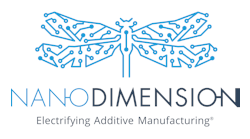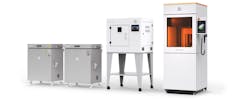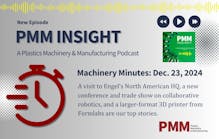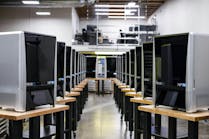The plastics machinery industry in China is growing up, coming of age for its own domestic production and in its willingness and ability to export. This was apparent during Chinaplas, held recently in Guangzhou, especially in the ways in which equipment suppliers showcased their capabilities.
Design is becoming a bigger topic and suppliers are melding machinery and equipment technologies from several continents to come up with solutions.
Two key themes emerged during Chinaplas that demonstrate the maturation of the industry and that have implications for equipment innovations in the future.
Energy efficiency and automation
Nearly every machine or piece of equipment throughout the show floor boasted an indicator of energy efficiency or smart production. Green means gold, or so suppliers are hoping.
Adsale Exhibition Services Ltd., Hong Kong, the organizer of Chinaplas, had an entire section dedicated to robotics. "The Robot Parade" included more than a dozen suppliers and "humanized" machines. Robots from Wittmann Battenfeld Inc., Torrington, Conn., were playing basketball. Ease of integration into work cells was a key advantage for many suppliers. The e-pic robot from Engel Austria GmbH, Schwertberg, Austria, which PMM covered in detail in last month's issue, made its first Asian outing in Guangzhou. The fact that Engel showcased its entire robot product range illustrates that automation is becoming much more important in Asia. Local governments in China also are investing in automation by providing incentives for processors. This is happening particularly in Guangzhou in southern China and in nearby Dongguan. Companies in these cities also happen to struggle with hiring workers.
"China's wage gap is closing and their need to think efficiency, to not throw human beings at it but to throw technology at it, to automate, now it's here," commented one equipment official.
Shini Plastics Technologies Inc. showed an automated production system manufacturing a cup used on airlines with the goal of illustrating how easily its equipment can integrate into a production line. The system had automated material handling, rapid prototyping and high-speed parts removal with the added advantages of improved production efficiencies with visual-control technology and reduced production costs with energy-control technology. Production data can be read in real time by the network-integrated control technology.
One official with Shini said China is experiencing flattened growth and the company is seeing small orders that are very customized and specialized. Shini is focusing on energy savings in its chillers and reducing machine footprints as floor space is getting more expensive in many places. This is challenging the company to redesign components on some equipment.
We cover each of the automation innovations more fully here.
Evolution in investments,
expansions and innovations
International machinery and equipment companies are deploying more resources into the Asian market. That may include building facilities or making key personnel investments, but the strategies are very finessed and sophisticated. Milacron LLC, Batavia, Ohio, announced its expansion of hot-runner capacity in Kunshan, China, during a press conference on May 20. The company had two booths at Chinaplas, one for mold technology and the other for primary equipment.
"China continues to be a leader with technology development," one Milacron official said. Among its innovations, Milacron was showing its E-Multi auxiliary injection unit for two-shot or multi-layer applications. The unit is finding use in liquid silicone rubber applications, especially for the medical field.
Several other suppliers reported being focused on getting innovations out the door very, very quickly. Those innovations aren't necessarily new products but upgrades or incremental changes to existing products. To that end, one supplier has decentralized product development from a European office, for example, into its offices in Shanghai where it trained locals who are fluent in the language and can operate within the same time zone as customers. Some of the innovations realized there will make their way to North America. It is the natural evolution of technology sharing.
Century Extrusion's Bob Urtel talked about adapting his company's twin-screw compounding extrusion machines for a global market. Century operates from Traverse City, Mich., as the U.S. arm of CPM Extrusion Group. Ruiya Extrusion, also part of the CPM Extrusion Group, operates from Nanjing, China, for that market. Its CX-HO Series is targeted at the Chinese market and has content appropriate for the local market, which includes Siemens controls. CPM Extrusion Group is touting it as one of the highest torque machines in the market. The CXE-HO Series was launched at NPE for the North American market; the CX series was introduced at Chinaplas. It is a globally capable machine, but the idea is to have machinery that can be serviced at the local level.
Did you attend Chinaplas? Please share your thoughts about the equipment innovations with us at [email protected].
Angie DeRosa, managing editor







